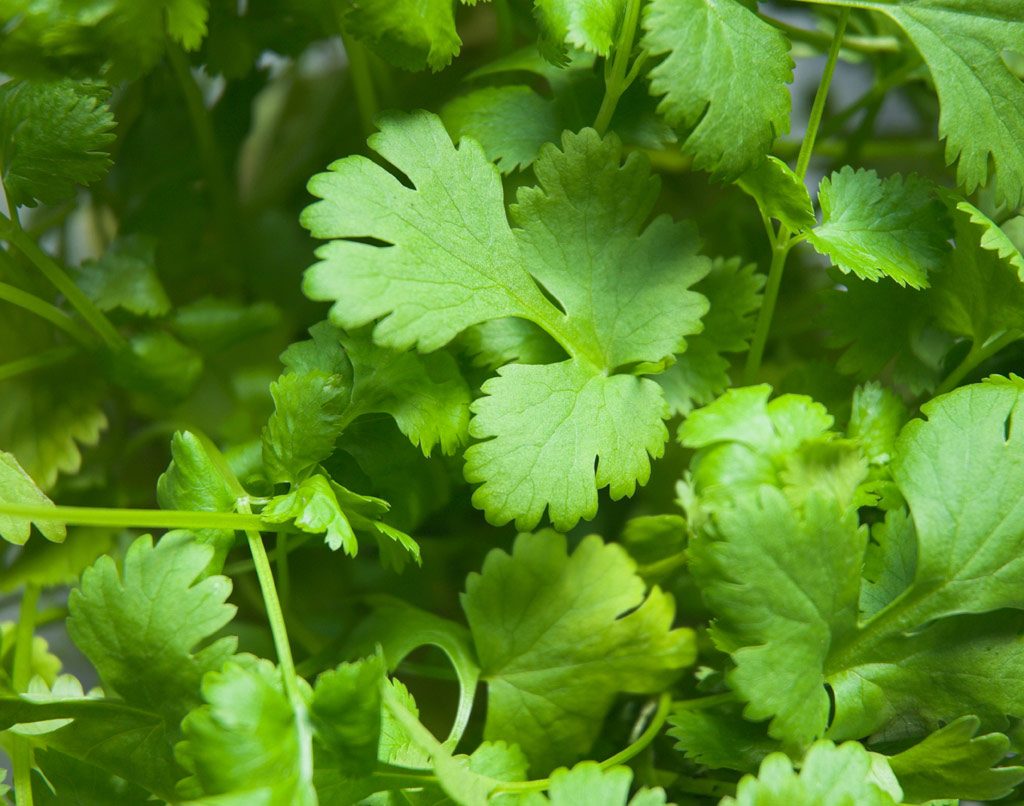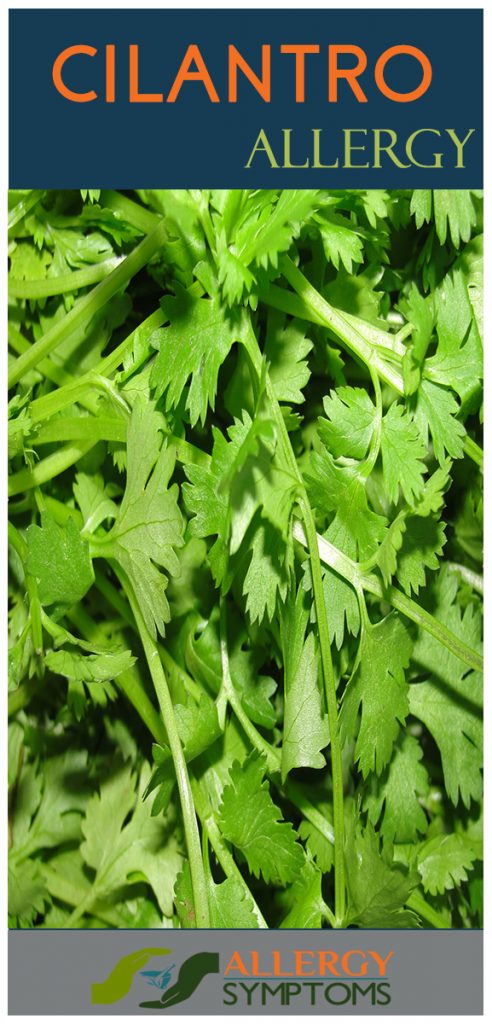Cilantro is a lacy leafed herb that is used to flavour foods and it is famous in Tex-Mex dishes in scrupulous. Cilantro resembles coriander but it has much extra consuming odor and also the taste.
Its seeds are well known as coriander and they are passing on with a dissimilar flavour than cilantro and this are not used to flavour the same types of dishes. All the parts of the cilantro plant are not poisonous, and it is easily available all year long.
An allergy to the cilantro is rare but it does not come about, you may have a privileged probability of just beginning an allergy to cilantro if you are allergic to birch pollen. Cilantro refers to the leafy stems of the Coriandrum Sativum Plant, which is also at times known as Chinese parsley.
In U.S, coriander frequently refers to the seeds of the plant that can also be ground into a spice. It is possible to be allergic to the plant’s coriander seeds or to the coriander spice made from the ground seeds.
Cilantro Allergy Symptoms
The symptoms of a cilantro allergy are mostly the same as any other food allergy. The reaction can be experienced in range from mild to life threatening. Symptoms of cilantro allergy may resemble those of other food allergies. These may include:
- Hives
- Swollen, itchy tongue or lips
- Stomach pain, including vomiting and cramps
- Diarrhea
A severe cilantro allergy could be also leading to anaphylaxis, potentially and brutal life threatening allergic reaction. The symptoms of anaphylaxis from a cilantro allergy are including:
- Dizziness
- Weak pulse
- Difficulty in breathing, including shortness of the breath
- Wheezing
- Facial swelling
Whilst anaphylaxis is not familiar with a cilantro allergy then it is imperative to search for an emergency medical consideration if you are experience the above symptoms.
Cilantro Allergy

An allergy to cilantro is classified as a food allergy, eating a dish which is containing cilantro can trigger an immune reaction soon after ingesting it.
Your immune system might inaccuracy substance in cilantro as damaging and liberates antibodies it is called as IgE, or immuglobulin E, which exertion to counterbalance the perceived threat.
Histamine is also released, which accounts for most of the symptoms of an allergic reaction. The medical periodical “Allergy” reports that the essences that are causing an allergic reaction to coriander, or cilantro seeds, are a category of protein.
Oral Allergy Syndrome
Cilantro can be also causing a type of allergy that is known as oral allergy syndrome, which is also known as food-pollen allergy. It is caused by the cross reactivity between the certain plant pollen proteins and also some of the raw fruits, nuts, vegetables and spices.
If you are having an allergy to certain types of the plant pollen, then you may also experience a milder reaction to foods of related plant species.
For example, if you are allergic to the birch pollen, then you may also experience an oral allergy to some foods that are including apples, plums, cherries, peaches, celery, walnuts, potatoes, almonds, coriander and fennel.
Symptoms comprise itchiness or bump of the mouth and throat, and gum irritation. Oral allergy syndrome occurs because proteins in these foods are structurally comparable to allergy causing proteins in birch pollen and predictable by the body as allergens.
Anaphylactic Shock
While tremendously rare, it is possible that you can have an anaphylactic reaction to the coriander, or cilantro seeds. Anaphylactic shock is a life threatening allergic reactions that require immediate medical attention.
This type of the allergic reaction occurs immediately, by causing you all of the body tissues to leave go of the histamine.
The symptoms of the anaphylactic shock are together with inflammation of the face, abdominal cramping, anxiety, perplexity, difficulty in the breathing & swallow, fainting, shock and loss of realization, irregular heartbeat, and drop in blood pressure. This is an emergency situation and if this not treated immediately, it can be deadly.
Treating Cilantro Allergy
Avoiding all kinds of the food which are containing cilantro and coriander is compulsory to put off the reappearance. Anti histamine drugs can be very helpful to control the mild allergic symptoms.
Application of the skin cream and lotions can be also helpful for to eliminate the skin disorders that are caused by the cilantro allergy reaction. Severe anaphylaxis needs to well-timed medical intrusion.
There is no cause to get worried if you have been diagnosed with cilantro allergy though. Simply check the ingredients of Tex-Mex, Asian and Indian dishes and you are going to be just fine and satisfied with it.

What should I do if I am having an allergic reaction to cilantro?
The minute you face a cilantro allergic reaction, you should seek immediate medical help. You may not know, however, Anaphylaxis can turn out to be life-threatening. It could occur right after someone is exposed to an allergen. The moment you develop rashes on your skin, feel nauseous, high pulse or start vomiting without any reason, immediately contact the doctor.
In case, you are with someone who is experiencing anaphylaxis, you should do the following things:
- Immediately call for the ambulance
- Keep them moving if they are vomiting or bleeding
- Cover the person with a blanket
- Help the person to gently lie on his or her back
- Try to maintain a calm environment to keep the person calm
- See if the person has an emergency Epi-Pen with himself
- Ensure that the clothing is loose so that the person can breathe properly
- In case, the person is having trouble breathing then him or her a CPR
- If the person is having trouble breathing then avoid lifting his or her head, anything to drink and giving oral medicines
Epi-Pen is prescribed to everyone who is allergic to certain food items or ingredients. Epi-Pen is mainly used in case of emergency, to get immediate relief from the allergic reaction. The doctor runs the required cilantro allergy test to determine the seriousness of the allergy.
However, it is still recommended to avoid the intake of any allergic triggers, as one may not have Epi-Pen always.
Is it possible that I can have a cilantro allergy if it tastes like soap?
The majority of people find that cilantro has anastysoapy taste. According to a study, the soapy taste is not usually because of the allergy. However, it could be due to genetic variations.
The scientist has found a strong link between those who think that cilantro tastes like soap and those who have a genetic variation that influences a particular olfactory receptor gene, called OR6A2. This olfactory receptor gene affects a person’s sense of smell.
The OR6A2 influence is sensitive to aldehyde chemicals that are a major part of what gives cilantro its smell. The study suggests that a dislike of cilantro is driven by its smell and is due to how your genes code your nose to respond to the chemicals that give cilantro.
Food items to avoid
In case you notice that you have an allergy to cilantro, it is important to side-by-side work with your doctor to confirm that cilantro is the allergic trigger. Once you recognize that you are allergic to cilantro, immediately remove it from your daily diet.
In case you feel anycilantro allergy symptom, it is recommended to avoid allergic triggers. Moreover, one also needs to know what to do if you accidentally ingest the cilantro.
Some cuisines across the globe include cilantro in dishes. Cilantro is common in the majority of central and South American, Mediterranean, Asian, and Portuguese meals. In case, you are eating any type of food, whether in a restaurant or at home, make sure to double-check the ingredient list.
Always be careful when picking up the good items in the grocery store. Always read the label whether it contains cilantro or not.
Substitutes for certain food
Once you recognize your allergy, doctors will recommendsome food substitutes to maintain the necessary vitamins and protein flow in your body. Someone who is habitual eating a lot of cilantro should go for the food items listed below:
Parsley: parsley is considered one of the best substitutesfor cilantro. It is similar to cilantro in color and is a good fresh alternative. Even though it does not taste exactly like cilantro, however, it does provide similar color, texture, and an added herb flavor to dishes. However, sometimes the flavor tends to be a lot more bitter than cilantro.
Vietnamese Mint: also known as Rau Ram, Vietnamese Mist is another alternative of cilantro. It is not related to cilantro; therefore, people with cilantro allergy can eat it without any tension.
It is obvious to have allergies from certain things and sometimes it gets difficult to recognize the allergies. Therefore, it is important to notice the changes in your skin and body. If you feel that something is wrong with you, then do not hesitate to meet the doctor.

